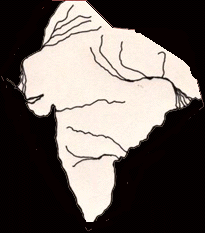| Art History 207~~Fall 1998 |
| Study Questions |
| Week 4 |
| Ajanta and Elephanta: study of the interconnection of sculpture, painting, and architecture |
|
1. Describe the site of Ajanta: why is it such an important site in Indian art? Are the caves Buddhist or Hindu? 2. How has the treatment of ornament developed at Ajanta, as for example in Cave 1? 3. Why are all the painted and carved figures (except those of Buddhas) at Ajanta dressed and jeweled in such a princely fashion? 4. In your own words, how does the representation of the Bodhisattva Avalokiteshvara in Cave I exemplify that figure's religious essence? 5. How do the paintings and sculpture at Ajanta reflect the maturation of Indian figural representation? How are they both similar to and different from the images at, for example, Karli? 6. What is the basic iconographic theme at the Great Cave of Shiva, at Elephanta? How is it developed throughout the cave? 7. What is the source of the term, 'Hindu'? What is meant by the 'Four Ends of Man,' i.e. dharma, artha, kama, and moksha? Sites of the Week :
a) Ajanta Further Readings:Elephanta, the cave of Shiva / photographs by Carmel Berkson; essays by Wendy Doniger O'Flaherty, George Michell, and Carmel Berkson. Princeton, N.J. : Princeton University Press, c1983. Collins, Charles D. The iconography and ritual of Siva at Elephanta Albany, NY : State University of New York Press, 1988. Spink, Walter. Ajanta to Ellora. Marg Publications for the Center for South and Southeast Asian Studies, University of Michigan [1967] Weiner, Sheila L. Ajanta : its place in Buddhist art . Berkeley : University of California Press, c1977. Burgess, James. Elura Cave temples. Varanasi, Indological Book House, 1972. Kramrisch, Stella. The presence of Siva . Princeton, N.J. : Princeton University Press, c1981. |
| Pallava and Chola stone and bronze sculpture |
|
1. Think about the sculptural frieze said to represent the Gangavatarana at Mamallapuram. How is the story told by the figures and their organization on the stone? Why should the sculptors have included so many images of animals in this relief? 2. How does the image of Shiva Nataraja tell the story of the creation, maintenance, and destruction of the world? What makes the tale one that is really enacted on a cosmic level? Further readings:Berkson, Carmel. The divine and demoniac: Mahisa's heroic struggle with Durga. Delhi; New York: Oxford University Press, 1995. |


